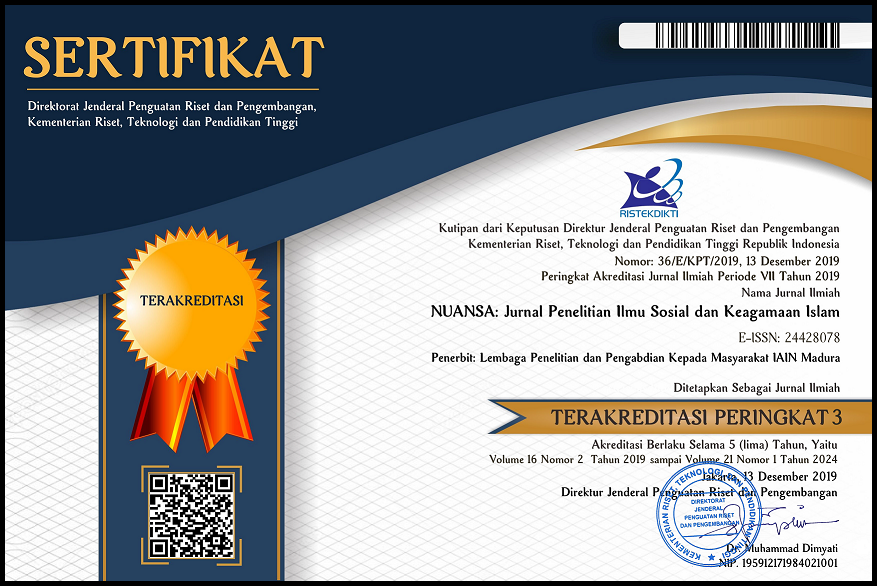PERDAGANGAN LADA DI SUNDA ABAD XVI
 Abstract views: 358
,
Abstract views: 358
,
 PDF downloads: 497
PDF downloads: 497
Abstract
This article examines the pepper trade carried out by the Sunda Kingdom in the 16th century. The topic of pepper trade was chosen because pepper was one of the main commodities that played an important role in the economy and international relations of the Sunda Kingdom. The main aim of this research is to examine the role of pepper as the main commodity of the Sunda Kingdom on the social and economic relations of the Sunda Kingdom. The research method used is historical research which consists of five stages, namely topic selection, heuristics, source criticism, interpretation, and historiography. This research is intended to examine (1) the Sunda Kingdom and the pepper trade, (2) the arrival of the Portuguese in Malacca, (3) Javanese geopolitics in the 16th century, (4) the 16th century pepper trade. The Sunda Kingdom had an agricultural and maritime character, with a focus on agriculture inland and trade in coastal areas. This kingdom planted pepper in the interior, which was then distributed to the big cities owned by the Sunda Kingdom for trade. The research results indicate that the pepper produced by the Sunda Kingdom is of high quality. This attracted the attention of the Portuguese to establish diplomatic relations. However, these efforts were thwarted by strong resistance from local kingdoms, especially Demak. The strategic position of the Sunda Kingdom in the maritime trade network is reflected in its extensive economic interactions, including trade relations with China, Malacca, and others. The diversity of networks and intensity of trade emphasize the influence of pepper in determining the political and economic situation of that time.
Downloads
References
Arifia, S., Zichem, R. Van, Arsyad, A., Sulfemi, W. B., & Zuchron, D. (2023). 16th Century Sundanese Royal Trade. International Journal of Social Service and Research, 3(9), 2173–2182. https://doi.org/10.46799/ijssr.v3i9.522
Ariwibowo, A. (2022). Kerajaan Banten Girang Dan Formasi Perdagangan Rempah Di Selat Sunda Abad X – Xvi. Pangadereng : Jurnal Hasil Penelitian Ilmu Sosial Dan Humaniora, 8(2), 229–250. https://doi.org/10.36869/pjhpish.v8i2.268
Arman, D. (2017). Dari Hulu Ke Hilir Batanghari : Aktivitas Perdagangan Lada di Jambi abad XVI-XVIII.
Armando, Cortessao. 1944. The Summa Orientas of Tome Pires. London.
Baihaqi, A. (2023). Analisis Kemajuan Kerajaan Demak (1478 – 1550 M). Tarikhuna, 3(02), 2023. https://mahadalyjakarta.com/ejournal/index.php/TARIKHUNA/article/view/36
Fauzan, E. H., Hamid, A. R., & Masykuroh, S. (2023). Perubahan Hubungan Lampung dengan Banten dalam Perdagangan Lada abad XVI-XVIII. Jawi, 6(2), 85. https://doi.org/10.24042/00202361942100
Hageman, J. 1867. "Geschiedenis der Soenda-landen". dalam Tijdschrift voor Indisch,Taal-, Land- en Volkenkunde Seri ke-5, Deel XVI: 193-251.
Hardjiwidjono, D. (n.d.). kisah runtuhnya malaka menurut sumber sumber portugis.
Haryani, D. (2018). Kerajaan Islam Demak Di Jawa Masa Pemerintahan.
Leirissa, R. Z. (1995). Sunda Kelapa sebagai bandar jalur sutra: kumpulan makalah diskusi.
Mahfudzoh, A. (2018). Hubungan Perdagangan Cirebon dan Sunda Kalapa Abad XVI : Suatu Studi Sejarah Ekonomi.
Maulana, D. (2015). Peran Jaka Tingkir Dalam Merintis Kerajaan Pajang 1546-1586 M. UIN Syarif Hidayatullah, 22–24. https://repository.uinjkt.ac.id/dspace/bitstream/123456789/28866/3/DEDE MAULANA-FAH.pdf
Meilink-Roelofsz, M. A. P., (1962). Asian Trade and European Influence: In the Indonesian Archipelago Between 1500 and about 1630. The Hague: Martinus Nijhoff.
Mulyanto, H. (2023). Kontribusi Epigrafi Kolonial Sebagai Penyedia Sumber Sejarah : Studi Kasus Makam VOC , Tugu Chastelein , dan Prasasti Padrão.
Munandar, A. A. (1994). Penataan Wilayah pada Masa Kerajaan Sunda. Berkala Arkeologi, 14(2), 95–105. https://doi.org/10.30883/jba.v14i2.706
Nastiti, T. S., & Djafar, H. (2017). Prasasti-Prasasti Dari Masa Hindu Buddha (Abad Ke-12-16 Masehi) Di Kabupaten Ciamis, Jawa Barat. PURBAWIDYA: Jurnal Penelitian Dan Pengembangan Arkeologi, 5(2), 101. https://doi.org/10.24164/pw.v5i2.115
Nurlidianti, N., Siregar, I., & Purnomo, B. (2023). Jalur Perdagangan Lada Sebagai Tiang Ekonomi Daerah Kemaritiman Pada Kesultanan Banten. Krinok: Jurnal Pendidikan Sejarah Dan Sejarah, 2(1), 33–41. https://doi.org/10.22437/krinok.v2i1.24531
Pradjoko, D. (2013). Atlas Pelabuhan-Pelabuhan Bersejarah di Indonesia.
Prasetya, D. M. (2017). Geopolitik Bantuan Luar Negeri Dari Perang Dingin sampai Globalisasi. Jurnal Sosial Politik, 2(1), 16. https://doi.org/10.22219/sospol.v2i1.4753
Putri, Z., Sejarah, P., Sriwijaya, U., Sejarah, P., & Sriwijaya, U. (2021). Sejarah Kesultanan Demak: Dari Raden Fatah Sampai Arya Penangsang Zuliani. Jurnal Sejarah Dan Kebudayaan Islam, 9(1).
Rahardjo, S., Anggraeni, N., Nastiti, T., & Ramelan, W. (2018). Warisan Budaya Maritim Nusantara. In Pertemuan Ilmiah Arkeologi (PIA) XIV. rumahbelajar.id
Rahman, F. (2019). “Negeri Rempah-Rempah” Dari Masa Bersemi Hingga Gugurnya Kejayaan Rempah-Rempah. Patanjala : Jurnal Penelitian Sejarah Dan Budaya, 11(3), 347.
Raja, P. (2022). “MEMPERTEGUH EKSISTENSI NKRI MELALUI JALUR REMPAH LADA LAMPUNG SEBAGAI WARISAN SEJARAH DUNIA” Agustus 2022 BANDAR LAMPUNG, INDONESIA. In Prosing Seminar Nasional (Vol. 4, Issue 1). http://sejarah.fkip.unila.ac.id/semnas-sejarah/https://doi.org/10.30959/patanjala.v11i3.527
Reid, A. (n.d.). Asia Tenggara Dalam Kurun Niaga 1450-1680 jilid 2: jaringan perdagangan global.
Rejeki, K. S. (2019). Peranan Ratu Kalinyamat Dalam Perkembangan Kota Jepara (1549-1579). Sosio E-Kons, 11(2), 174–182.
Rockhill, W. . (1914). “Notes on the Relations and Trade of China with the Eastern Archipelago and the Coast of the Indian Ocean During the Fourteenth Century (part I)”. T’oung Pao. 15(1). http://repositorio.unan.edu.ni/2986/1/5624.pdf%0Ahttp://fiskal.kemenkeu.go.id/ejournal%0Ahttp://dx.doi.org/10.1016/j.cirp.2016.06.001%0Ahttp://dx.doi.org/10.1016/j.powtec.2016.12.055%0Ahttps://doi.org/10.1016/j.ijfatigue.2019.02.006%0Ahttps://doi.org/10.1
Sa, A. B. De. (1954). DOCUMENTAÇÃO PARA A HISTÓRIA DAS MISSÕES DO PADROADO PORTUGUÊS ORIENTE. Lisboa : Agência geral do ultramar, Divisãao de Publicações e Biblioteca.
Samingan, & Roe, Y. T. (2021). Kedatangan Bangsa Portugis: Berdagang dan Menyebarkan Agama Katolik di Nusa Tenggara Timur. Historis : Jurnal Kajian, Penelitian Dan Pengembangan Pendidikan Sejarah, 6(1), 18–24.
Sulistiyono, S. T. (2008). Kejayaan Budaya Maritim di Pantai Utara Jawa dan Refleksi Membangun Indonesia sebagai Negara Bahari Menyambung Mata Rantai yang putus.pdf. IKAHAMSI, 1(2).
Syafiera, A. (2016). Perdagangan di Nusantara Abad ke-16. Journal Pendidikan Sejarah, 4(3), 721–735.
Tundjung, & Hidayat, A. (2018). Politik Dinasti dalam Perspektif Ekonomi dari Kerajaan Demak. Jurnal Alun Sejarah, 3(1), 1–13. https://journal.lppmunindra.ac.id/index.php/alursejarah/article/view/2847/2052
Tundjung, & Roviyanti, R. (2020). Dari Sunda Kelapa ke Tanjung Priok. Jurnal Pendidikan Sejarah, 4(1), 162–170.
Wijaya, D. N. (2022). Malacca Beyond European Colonialism (15th-17th Centuries).
Zakaria, M. M. (2019). Kondisi Sosial-Ekonomi Masyarakat Kuna Tatar Sunda (Abad V –XVI). Metahumaniora, 9(1), 85. https://doi.org/10.24198/mh.v9i1.22867
Copyright (c) 2024 NUANSA: Jurnal Penelitian Ilmu Sosial dan Keagamaan Islam

This work is licensed under a Creative Commons Attribution-NonCommercial 4.0 International License.
The journal operates an Open Access policy under a Creative Commons Attribution-NonCommercial 4.0 International License (CC-BY-NC) 
Authors who publish with this journal agree to the following terms:
- Authors retain copyright and grant the journal right of first publication with the work simultaneously licensed under a Creative Commons Attribution License that allows others to share the work with an acknowledgement of the work's authorship and initial publication in this journal.
- Authors are able to enter into separate, additional contractual arrangements for the non-exclusive distribution of the journal's published version of the work (e.g., post it to an institutional repository or publish it in a book), with an acknowledgement of its initial publication in this journal.
- Authors are permitted and encouraged to post their work online (e.g., in institutional repositories or on their website) prior to and during the submission process, as it can lead to productive exchanges, as well as earlier and greater citation of published work.





















